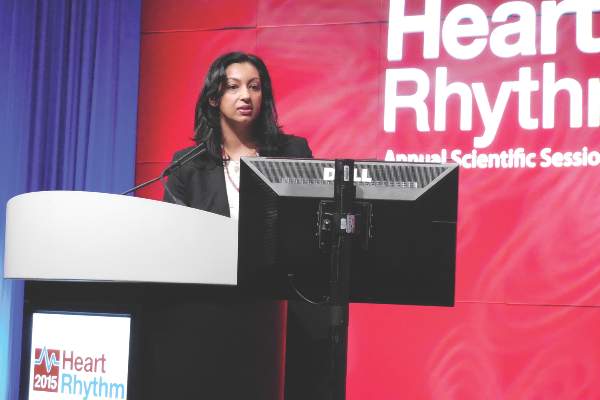User login
BOSTON – The problem-plagued St. Jude Riata leads for implantable cardioverter defibrillators, pulled from the U.S. market in 2010, continue to pose problems for the tens of thousands of patients who still have them as clinicians follow these patients out to periods approaching 10 years.
But the risks of lead extraction continue make prophylactic lead removal a poor option for most patients, leaving the alternative of continuing to closely monitor patients for episodes of electrical lead failure, Dr. Ratika Parkash said at the annual scientific sessions of the Heart Rhythm Society.
“Isolated, prophylactic lead revision or extraction is not warranted,” said Dr. Parkash, a cardiac electrophysiologist at Dalhousie University in Halifax, Canada. “We need to take into account a patient’s comorbidities compared with the possibility of cable externalization,” when the conducting cable of the lead moves outside its insulating sheath, one of the main problems with the St. Jude Riata leads, she explained. “I think we need to individualize what we do” based on each patient’s specific situation, but perhaps collecting more data during another 2 years follow-up might shed more light on this issue, she said. Dr. Parkash and her associates followed Riata-lead recipients for an average of 7.5 years to produce the current report.
Although no U.S. patient has received a Riata lead for nearly 5 years, the Food and Drug Administration estimated that at the time St. Jude stopped selling this lead in late 2010 more than 227,000 Riata leads had gone into patients worldwide, including about 79,000 U.S. patients. Last February, St. Jude announced that it had settled 950 lawsuits or claims from U.S. patients who had received Riata leads.
The CREDO (Canadian Registry of Cardiac Implantable Electronic Device Outcomes) prospective registry review reported by Dr. Parkash included data from 2,707 patients who received Riata leads at any of 15 Canadian centers, representing 60% of the 4,538 Canadian residents who had received on of these leads. The patients averaged 63 years of age, 19% were women, 70% had received an 8 French lead and 30% had received a 7F lead, and follow-up data were available for an average of 7.5 years from the time patients received the leads to attach their implantable cardioverter defibrillator (ICD) to their heart.
During follow-up, 378 of the 2,707 patients (14%) required revision of their leads, a rate well above the rates seen collectively for all ICD lead models in data collected in both randomized trials and in the U.S. national registry of ICD implantations maintained by the National Cardiovascular Data Registry (OpenHeart 2015;2: [doi:10.1136/openhrt-2014-000198]). The rate of lead revisions seen with the Riata lead, 14% during 7.5 years follow-up, puts it in the ballpark of the 17% lead-failure rate with 5 year follow-up seen in Canadian patients who received a Sprint Fidelis lead that was marketed by Medtronic.(Circulation 2012:1217-25)
Triggering the 378 Riata revisions were electrical abnormalities, in 42%, lead dislodgement in 18%, cable externalization in 12%, infection in 12%, and several other types of events causing the other revisions.
The rate of electrical failures remained steady throughout follow-up, averaging about 0.8%/ year for both the 8F leads, which the researchers could follow for up to 10 years, and for the 7F leads, which they followed out to as long as 8 years. Cable externalizations occurred in 7% of the 8F leads and in 5% of the 7F leads, a difference that was not statistically significant. Fewer than half the patients, 1,187 (44%) underwent radiographic assessment of cable externalization. About 90% of all the detected cable externalizations in both the 7F and 8F leads did not produce electrical failure.
A multivariate analysis identified two factors independently linked with lead failure: patient age and left ventricular ejection fraction. Every 10 years of additional patient age linked with a 16% reduced rate of lead failure. And every 10% in additional ejection fraction linked with a 26% increased rate of lead failure.
The Canadian experience also documented the risk of undergoing lead revision, which happened for 253 patients and which led to 16 major complications, a 6% rate. Fifteen of the 16 major complications occurred without lead extraction taking place. Also, the major complications occurred at roughly similar rates in patients with 7F or 8F leads.
Dr. Parkash also highlighted that cable externalization often occurs late after implantation, and so additional cases are still possible. “We may just be seeing the cusp of lead failure” in the data collected so far, she suggested.
One concern the new data did not stoke is the risk for lead shorting that produces sudden ICD failure. “I think [shorting] is not as much of a problem as we previously thought,” Dr. Parkash said.
“These data give credence to the strategy of keeping the Riata leads in place, and, if you are concerned about their function, capping them and putting in a new lead,” commented Dr. Fred M. Kusumoto, an electrophysiologist and professor of medicine at the Mayo Clinic, Florida in Jacksonville. In addition, the new data demonstrate that the problem is in both the 7F as well as the 8F leads. “The entire Riata design was not very good,” he said in an interview. But a reassuring result in the Canadian registry was the low rate of shorting, or high-voltage failure of the lead, Dr. Kusumoto said.
On Twitter @mitchelzoler
We need to know what happens to the Riata lead over time, so these are very important findings. The continuous increase in adverse lead events over time is concerning. It raises the question of what is the best strategy for monitoring patients who have a Riata lead. Is there something else we should be doing to better identify patients who are having a lead problem?
 |
| Mitchel L. Zoler/Frontline Medical News Dr. Andrea M. Russo |
For example, some electrophysiologists propose testing the ongoing function of Riata leads with a high-voltage test. We don’t yet know if this test would benefit patients, but these data give us better perspective on the risks these patients face.
The cable externalization seen with the Riata lead is an unusual type of lead failure that is different from what we see with most leads for implantable cardioverter defibrillators. In addition, no data exist to support routine extraction of these leads. The Food and Drug Administration has recommended “close monitoring” and regular imaging of the leads, but beyond that different centers handle follow-up in different ways.
We need a better way to screen for electrical failure because x-ray imaging alone does not seem effective enough. It will be interesting to see the results after the Canadian researchers do a more detailed analysis of their data to provide further insight into effective methods for screening patients with Riata leads.
Dr. Andrea M. Russo is professor and director of the electrophysiology and arrhythmia service at Cooper University Hospital in Camden, N.J. She made these comments in an interview. Dr. Russo has been a consultant to St. Jude, Biotronik, Boston Scientific and Medtronic.
We need to know what happens to the Riata lead over time, so these are very important findings. The continuous increase in adverse lead events over time is concerning. It raises the question of what is the best strategy for monitoring patients who have a Riata lead. Is there something else we should be doing to better identify patients who are having a lead problem?
 |
| Mitchel L. Zoler/Frontline Medical News Dr. Andrea M. Russo |
For example, some electrophysiologists propose testing the ongoing function of Riata leads with a high-voltage test. We don’t yet know if this test would benefit patients, but these data give us better perspective on the risks these patients face.
The cable externalization seen with the Riata lead is an unusual type of lead failure that is different from what we see with most leads for implantable cardioverter defibrillators. In addition, no data exist to support routine extraction of these leads. The Food and Drug Administration has recommended “close monitoring” and regular imaging of the leads, but beyond that different centers handle follow-up in different ways.
We need a better way to screen for electrical failure because x-ray imaging alone does not seem effective enough. It will be interesting to see the results after the Canadian researchers do a more detailed analysis of their data to provide further insight into effective methods for screening patients with Riata leads.
Dr. Andrea M. Russo is professor and director of the electrophysiology and arrhythmia service at Cooper University Hospital in Camden, N.J. She made these comments in an interview. Dr. Russo has been a consultant to St. Jude, Biotronik, Boston Scientific and Medtronic.
We need to know what happens to the Riata lead over time, so these are very important findings. The continuous increase in adverse lead events over time is concerning. It raises the question of what is the best strategy for monitoring patients who have a Riata lead. Is there something else we should be doing to better identify patients who are having a lead problem?
 |
| Mitchel L. Zoler/Frontline Medical News Dr. Andrea M. Russo |
For example, some electrophysiologists propose testing the ongoing function of Riata leads with a high-voltage test. We don’t yet know if this test would benefit patients, but these data give us better perspective on the risks these patients face.
The cable externalization seen with the Riata lead is an unusual type of lead failure that is different from what we see with most leads for implantable cardioverter defibrillators. In addition, no data exist to support routine extraction of these leads. The Food and Drug Administration has recommended “close monitoring” and regular imaging of the leads, but beyond that different centers handle follow-up in different ways.
We need a better way to screen for electrical failure because x-ray imaging alone does not seem effective enough. It will be interesting to see the results after the Canadian researchers do a more detailed analysis of their data to provide further insight into effective methods for screening patients with Riata leads.
Dr. Andrea M. Russo is professor and director of the electrophysiology and arrhythmia service at Cooper University Hospital in Camden, N.J. She made these comments in an interview. Dr. Russo has been a consultant to St. Jude, Biotronik, Boston Scientific and Medtronic.
BOSTON – The problem-plagued St. Jude Riata leads for implantable cardioverter defibrillators, pulled from the U.S. market in 2010, continue to pose problems for the tens of thousands of patients who still have them as clinicians follow these patients out to periods approaching 10 years.
But the risks of lead extraction continue make prophylactic lead removal a poor option for most patients, leaving the alternative of continuing to closely monitor patients for episodes of electrical lead failure, Dr. Ratika Parkash said at the annual scientific sessions of the Heart Rhythm Society.
“Isolated, prophylactic lead revision or extraction is not warranted,” said Dr. Parkash, a cardiac electrophysiologist at Dalhousie University in Halifax, Canada. “We need to take into account a patient’s comorbidities compared with the possibility of cable externalization,” when the conducting cable of the lead moves outside its insulating sheath, one of the main problems with the St. Jude Riata leads, she explained. “I think we need to individualize what we do” based on each patient’s specific situation, but perhaps collecting more data during another 2 years follow-up might shed more light on this issue, she said. Dr. Parkash and her associates followed Riata-lead recipients for an average of 7.5 years to produce the current report.
Although no U.S. patient has received a Riata lead for nearly 5 years, the Food and Drug Administration estimated that at the time St. Jude stopped selling this lead in late 2010 more than 227,000 Riata leads had gone into patients worldwide, including about 79,000 U.S. patients. Last February, St. Jude announced that it had settled 950 lawsuits or claims from U.S. patients who had received Riata leads.
The CREDO (Canadian Registry of Cardiac Implantable Electronic Device Outcomes) prospective registry review reported by Dr. Parkash included data from 2,707 patients who received Riata leads at any of 15 Canadian centers, representing 60% of the 4,538 Canadian residents who had received on of these leads. The patients averaged 63 years of age, 19% were women, 70% had received an 8 French lead and 30% had received a 7F lead, and follow-up data were available for an average of 7.5 years from the time patients received the leads to attach their implantable cardioverter defibrillator (ICD) to their heart.
During follow-up, 378 of the 2,707 patients (14%) required revision of their leads, a rate well above the rates seen collectively for all ICD lead models in data collected in both randomized trials and in the U.S. national registry of ICD implantations maintained by the National Cardiovascular Data Registry (OpenHeart 2015;2: [doi:10.1136/openhrt-2014-000198]). The rate of lead revisions seen with the Riata lead, 14% during 7.5 years follow-up, puts it in the ballpark of the 17% lead-failure rate with 5 year follow-up seen in Canadian patients who received a Sprint Fidelis lead that was marketed by Medtronic.(Circulation 2012:1217-25)
Triggering the 378 Riata revisions were electrical abnormalities, in 42%, lead dislodgement in 18%, cable externalization in 12%, infection in 12%, and several other types of events causing the other revisions.
The rate of electrical failures remained steady throughout follow-up, averaging about 0.8%/ year for both the 8F leads, which the researchers could follow for up to 10 years, and for the 7F leads, which they followed out to as long as 8 years. Cable externalizations occurred in 7% of the 8F leads and in 5% of the 7F leads, a difference that was not statistically significant. Fewer than half the patients, 1,187 (44%) underwent radiographic assessment of cable externalization. About 90% of all the detected cable externalizations in both the 7F and 8F leads did not produce electrical failure.
A multivariate analysis identified two factors independently linked with lead failure: patient age and left ventricular ejection fraction. Every 10 years of additional patient age linked with a 16% reduced rate of lead failure. And every 10% in additional ejection fraction linked with a 26% increased rate of lead failure.
The Canadian experience also documented the risk of undergoing lead revision, which happened for 253 patients and which led to 16 major complications, a 6% rate. Fifteen of the 16 major complications occurred without lead extraction taking place. Also, the major complications occurred at roughly similar rates in patients with 7F or 8F leads.
Dr. Parkash also highlighted that cable externalization often occurs late after implantation, and so additional cases are still possible. “We may just be seeing the cusp of lead failure” in the data collected so far, she suggested.
One concern the new data did not stoke is the risk for lead shorting that produces sudden ICD failure. “I think [shorting] is not as much of a problem as we previously thought,” Dr. Parkash said.
“These data give credence to the strategy of keeping the Riata leads in place, and, if you are concerned about their function, capping them and putting in a new lead,” commented Dr. Fred M. Kusumoto, an electrophysiologist and professor of medicine at the Mayo Clinic, Florida in Jacksonville. In addition, the new data demonstrate that the problem is in both the 7F as well as the 8F leads. “The entire Riata design was not very good,” he said in an interview. But a reassuring result in the Canadian registry was the low rate of shorting, or high-voltage failure of the lead, Dr. Kusumoto said.
On Twitter @mitchelzoler
BOSTON – The problem-plagued St. Jude Riata leads for implantable cardioverter defibrillators, pulled from the U.S. market in 2010, continue to pose problems for the tens of thousands of patients who still have them as clinicians follow these patients out to periods approaching 10 years.
But the risks of lead extraction continue make prophylactic lead removal a poor option for most patients, leaving the alternative of continuing to closely monitor patients for episodes of electrical lead failure, Dr. Ratika Parkash said at the annual scientific sessions of the Heart Rhythm Society.
“Isolated, prophylactic lead revision or extraction is not warranted,” said Dr. Parkash, a cardiac electrophysiologist at Dalhousie University in Halifax, Canada. “We need to take into account a patient’s comorbidities compared with the possibility of cable externalization,” when the conducting cable of the lead moves outside its insulating sheath, one of the main problems with the St. Jude Riata leads, she explained. “I think we need to individualize what we do” based on each patient’s specific situation, but perhaps collecting more data during another 2 years follow-up might shed more light on this issue, she said. Dr. Parkash and her associates followed Riata-lead recipients for an average of 7.5 years to produce the current report.
Although no U.S. patient has received a Riata lead for nearly 5 years, the Food and Drug Administration estimated that at the time St. Jude stopped selling this lead in late 2010 more than 227,000 Riata leads had gone into patients worldwide, including about 79,000 U.S. patients. Last February, St. Jude announced that it had settled 950 lawsuits or claims from U.S. patients who had received Riata leads.
The CREDO (Canadian Registry of Cardiac Implantable Electronic Device Outcomes) prospective registry review reported by Dr. Parkash included data from 2,707 patients who received Riata leads at any of 15 Canadian centers, representing 60% of the 4,538 Canadian residents who had received on of these leads. The patients averaged 63 years of age, 19% were women, 70% had received an 8 French lead and 30% had received a 7F lead, and follow-up data were available for an average of 7.5 years from the time patients received the leads to attach their implantable cardioverter defibrillator (ICD) to their heart.
During follow-up, 378 of the 2,707 patients (14%) required revision of their leads, a rate well above the rates seen collectively for all ICD lead models in data collected in both randomized trials and in the U.S. national registry of ICD implantations maintained by the National Cardiovascular Data Registry (OpenHeart 2015;2: [doi:10.1136/openhrt-2014-000198]). The rate of lead revisions seen with the Riata lead, 14% during 7.5 years follow-up, puts it in the ballpark of the 17% lead-failure rate with 5 year follow-up seen in Canadian patients who received a Sprint Fidelis lead that was marketed by Medtronic.(Circulation 2012:1217-25)
Triggering the 378 Riata revisions were electrical abnormalities, in 42%, lead dislodgement in 18%, cable externalization in 12%, infection in 12%, and several other types of events causing the other revisions.
The rate of electrical failures remained steady throughout follow-up, averaging about 0.8%/ year for both the 8F leads, which the researchers could follow for up to 10 years, and for the 7F leads, which they followed out to as long as 8 years. Cable externalizations occurred in 7% of the 8F leads and in 5% of the 7F leads, a difference that was not statistically significant. Fewer than half the patients, 1,187 (44%) underwent radiographic assessment of cable externalization. About 90% of all the detected cable externalizations in both the 7F and 8F leads did not produce electrical failure.
A multivariate analysis identified two factors independently linked with lead failure: patient age and left ventricular ejection fraction. Every 10 years of additional patient age linked with a 16% reduced rate of lead failure. And every 10% in additional ejection fraction linked with a 26% increased rate of lead failure.
The Canadian experience also documented the risk of undergoing lead revision, which happened for 253 patients and which led to 16 major complications, a 6% rate. Fifteen of the 16 major complications occurred without lead extraction taking place. Also, the major complications occurred at roughly similar rates in patients with 7F or 8F leads.
Dr. Parkash also highlighted that cable externalization often occurs late after implantation, and so additional cases are still possible. “We may just be seeing the cusp of lead failure” in the data collected so far, she suggested.
One concern the new data did not stoke is the risk for lead shorting that produces sudden ICD failure. “I think [shorting] is not as much of a problem as we previously thought,” Dr. Parkash said.
“These data give credence to the strategy of keeping the Riata leads in place, and, if you are concerned about their function, capping them and putting in a new lead,” commented Dr. Fred M. Kusumoto, an electrophysiologist and professor of medicine at the Mayo Clinic, Florida in Jacksonville. In addition, the new data demonstrate that the problem is in both the 7F as well as the 8F leads. “The entire Riata design was not very good,” he said in an interview. But a reassuring result in the Canadian registry was the low rate of shorting, or high-voltage failure of the lead, Dr. Kusumoto said.
On Twitter @mitchelzoler
AT HEART RHYTHM 2015
Key clinical point: During an average 7.5 years of follow-up Riata leads for implantable cardioverter defibrillators showed about a 0.8%/year failure rate.
Major finding: The Riata ICD leads showed a roughly 6% electrical failure rate and 7% total failure rate with 10-year follow-up.
Data source: CREDO, a prospective registry of ICD recipients at 15 Canadian centers which enrolled 2,707 patients who received Riata leads.
Disclosures: Dr. Parkash has been a consultant to St. Jude, Pfizer, and Bayer, and has received research funding from Schering-Plough and Medtronic. Dr. Kusumoto had no relevant disclosures.


